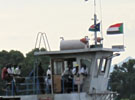
Increasingly frequent reports of violent clashes, deaths of women and children, and subsequent bouts of displacement in southern Sudan must not be ignored or dismissed as unrelated incidents. As the Economist recently noted, these episodes amount to “a sign of a wider breakdown of peace across southern Sudan.”
In early June, an attack by an armed Lou Nuer militia on a World Food Program river convoy carrying U.N. food aid reportedly killed at least 40 of the 150 southern soldiers acting as escorts. While intercommunal violence is not a new phenomenon in the southern Sudan, the attacks in 2009 have been characterized by the indiscriminate killing of women and children, which is a disturbing shift from the historical practices of cattle-raiding and other traditional issues related to land conflict.
So what is behind the recent violence in the South? At present, no news sources or analysts have been able to offer proof that the NCP-led government in Khartoum is arming proxy militias and deliberately attempting to destabilize the South. However, as we noted here yesterday, the NCP has a history of using brutal tactics to sow chaos throughout Sudan’s vast periphery, and one of these strategies is employing proxy militias to incite violence at the local level, from Darfur to the Nuba Mountains.
As a result of the mounting instability in the South, distrust between the NCP and the South’s SPLM-led government has grown.
While the NCP is likely at least partially responsible for the increased violence and security in the South since the beginning of 2009, the Government of Southern Sudan is also not acting under the assumption that the peace through the CPA is possible. A recent report by the Small Arms Survey warned that:
[GoSS] continues to be driven by the belief that a confrontation with the North is likely. This stance has shaped its current security strategy, which focuses on defending the border with the North and other strategic positions, as well as containing spoilers, including possible allies of Khartoum.
With its focus increasingly on these external pressures, the southern government is not devoting adequate attention to serious internal divisions and frequent violent flare-ups throughout the South. As Human Rights Watch noted in its latest report on the South, the attacks that killed more than 1,000 people in Jongeli state in March and April are evidence of the resounding failure of GoSS and the U.N. Mission in Sudan, or UNMIS, to protect civilians from the intercommunal violence threatening to engulf the South.
It is increasingly evident that there is a widespread breakdown of peace in southern Sudan, and that both the North and the South are bracing for war in 2011, regardless of concurrent recommitments to implementation of the faltering Comprehensive Peace Agreement. A major test to the ability of the parties to prevent a return to war will come in just a few weeks. No later than July 23, the Permanent Court of Arbitration in the Hague will issue its decision on the dispute over the boundaries of the long-contested, oil-rich area of Abyei at the crossroads of Sudan’s northern and southern regions. The aftermath of the Abyei announcement will be a gauge of the risk of violence in the remainder of the CPA’s interim period, and a bellwether for the prospects of peace when this period ends with the referendum on southern independence in 2011.
Katherine Carson contributed to this post.
Photo: A barge on the Nile flying the flags of both North and South Sudan. Enough/Maggie Fick

